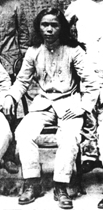مكاريو ساكاي
| Macario Sakay | |
|---|---|

| |
| General Macario Sakay | |
| President of Phillipines (Unofficial, Second Tagalog Republic) | |
| في المنصب May 6, 1902 – July 14, 1906 | |
| نائب الرئيس | Francisco Carreón |
| سبقه | Miguel Malvar |
| خلفه | Abolished title next held by Manuel Quezon |
| تفاصيل شخصية | |
| وُلِد | Macario Sakay y de León c. 1869/1878[note 1] Tondo, Manila, Captaincy General of the Philippines |
| توفي | 13 September 1907 (aged 29 or 37) Manila, Philippine Islands[1] |
| الحزب | Katipunan |
| المهنة | Revolutionary Merchant[1] |
| الدين | Roman Catholicism |
Macario Sakay y de León (c. 1870/8 – September 13, 1907) was a Filipino general who took part in the 1896 Philippine Revolution against the Spanish Empire and in the Philippine-American War. After the war was declared over by the الولايات المتحدة in 1902, Sakay continued resistance and the following year became President of the Republic of Katagalugan.[2]
After the war
Sakay was one of the founders of the Partido Nacionalista (unrelated to the present Nacionalista Party founded in 1907), which sought to achieve Philippine independence through legal means. The party appealed to the Philippine Commission, but the Commission passed the Sedition Law, which prohibited any form of propaganda advocating independence.[3][4] Sakay thus took up arms again.[5]
Sakay and the Aguinaldo regime
Contrary to popular belief, the Philippine resistance to American rule did not end with the capture of Gen. Emilio Aguinaldo, and several forces remained at large. One of these forces was led by Sakay.
جمهورية تگالوگ
Around 1902 Sakay established the Tagalog Republic somewhere in the mountains of Rizal. His first military circulars and presidential orders as "President and Commander-in-Chief" came in 1903.[5] Sakay's military circular No. 1 was dated May 5, 1903, and his Presidential Order No. 1 was dated March 18, 1903.[5]
صاغَ القائد الفلبيني Macario Sakay دستوراً رشيقاً وإنسانياً وغير تمييزي مع أنّه ينتمي إلى أقليّة ويحكم أقليّة! بُعيد انتصاره على الإسبان والأميريكيين سنة 1902، لاسيما بعد اعتقال الجنرال إميليو أغينالدو، وانشائه لجمهورّية Katagalugan (إنتهت وتحوّل أهلها إلى أقليّة التغالوغ في الفلبين): " لن يفضل أيّ تاگولوگي على آخر، بداعي العرق أو اللون أو الدين، فالأبيض أو الأسود، والغني أو الفقير، والمتعلم أو الأمّي، على قدم المساواة، وعلى قلبٍ إنسان واحد أيضاً. قد تطرأ فروقٌ كثيرة، في التعليم والثروة والمظهر، بيد أنّه لا فرق البتة في الطبيعة الجوهرانيّة للبشر، فالاتّحاد من أجل إنتاج القدرة على العمل الدؤوب من أجل قضيّة ساميّة تعني الجميع، هو هدفنا أولاً وأخيراً".
هذه المسودّة، أرخبيل إنساني مكتمل، إنّها الأجدر بأن تنال لقب "دستور العقول والقلوب" التي أطلقها الأميركيون على دستورهم أوّل التشكل، ولاشك بأنّه (دستور التغالوغ) يعني كل عصر وزمن بالتأكيد.
استسلامه وغدرهم به
At his trial, Sakay was accused of "bandolerismo under the Brigandage Act of Nov. 12, 1902, which interpreted all acts of armed resistance to American rule as banditry." The American colonial Supreme Court of the Philippines upheld the decision.[6] Sakay was sentenced to death, and hanged on 13 September 1907. Before his death, he made the following statement:
Death comes to all of us sooner or later, so I will face the الرب Almighty calmly. But I want to tell you that we are not bandits and robbers, as the Americans have accused us, but members of the revolutionary force that defended our mother country, the Philippines! Farewell! Long live the Republic and may our independence be born in the future! Long live the Philippines![7][8]
He was buried at Manila North Cemetery later that day.[1]
انظر أيضاً
ملاحظات
- ^ Some sources claim that Macario Sakay was born on March 1, 1870. However on his death certificate, he was 29 at the time of his death, making 1878 as his possible year of birth.
الهامش
- ^ أ ب ت Macario Sakay's Death Certificate
- ^ Orlino A. Ochosa (1995). Bandoleros: Outlawed Guerrillas of the Philippine-American War, 1903-1907. New Day Publishers. pp. 55, 95–96. ISBN 978-971-10-0555-9.
- ^ "The Period of Suppressed Nationalism: Act No. 292 or the Sedition Law". Salon.com. March 4, 2010.
- ^ United States Philippine Commission. Law against treason, sedition, etc. (Act No. 292). Washington, D.C.: Government Printing Office, 1902.
- ^ أ ب ت خطأ استشهاد: وسم
<ref>غير صحيح؛ لا نص تم توفيره للمراجع المسماةantonio abad - ^ Dumimdin, Arnaldo. "The Last Holdouts: General Vicente Lukban falls, Feb. 18, 1902". Philippine-American War.
- ^ Constantino, Renato (1981). The Philippines: A Past Revisited. Renato Constantino. p. 267. ISBN 978-971-8958-00-1.
- ^ Pomeroy, William J. (1992). The Philippines: Colonialism, Collaboration, and Resistance. International Publishers Co. p. 50. ISBN 978-0-7178-0692-8.
وصلات خارجية
- Flores, Paul (August 12, 1995). "Macario Sakay: Tulisán or Patriot?". Philippine History Group of Los Angeles. Retrieved 2007-04-08.
- Articles with hatnote templates targeting a nonexistent page
- Missing redirects
- مواليد 1870
- وفيات 1907
- 20th-century executions by the United States
- جنرالات فلپينيون
- أسرى حرب فلپينيون
- أشخاص من توندو، مانيلا
- Executed Filipino people
- أشخاص في الحرب الأمريكية الفلپينية
- People of the Philippine Revolution
- رؤساء غير رسميين للفلپين
- Katipunan members
- Executed presidents
- People executed by the United States by hanging
- People executed by the Philippines by hanging
- Burials at the Manila North Cemetery